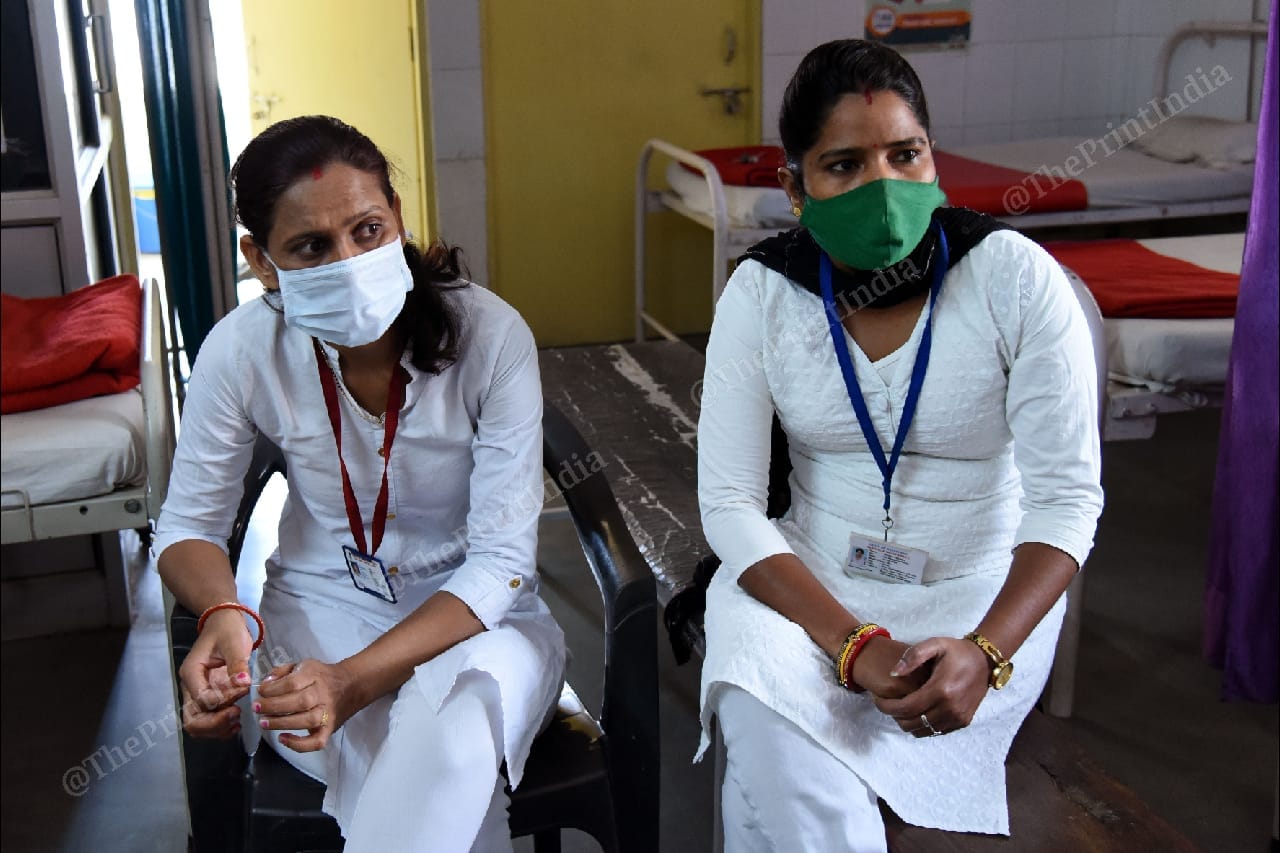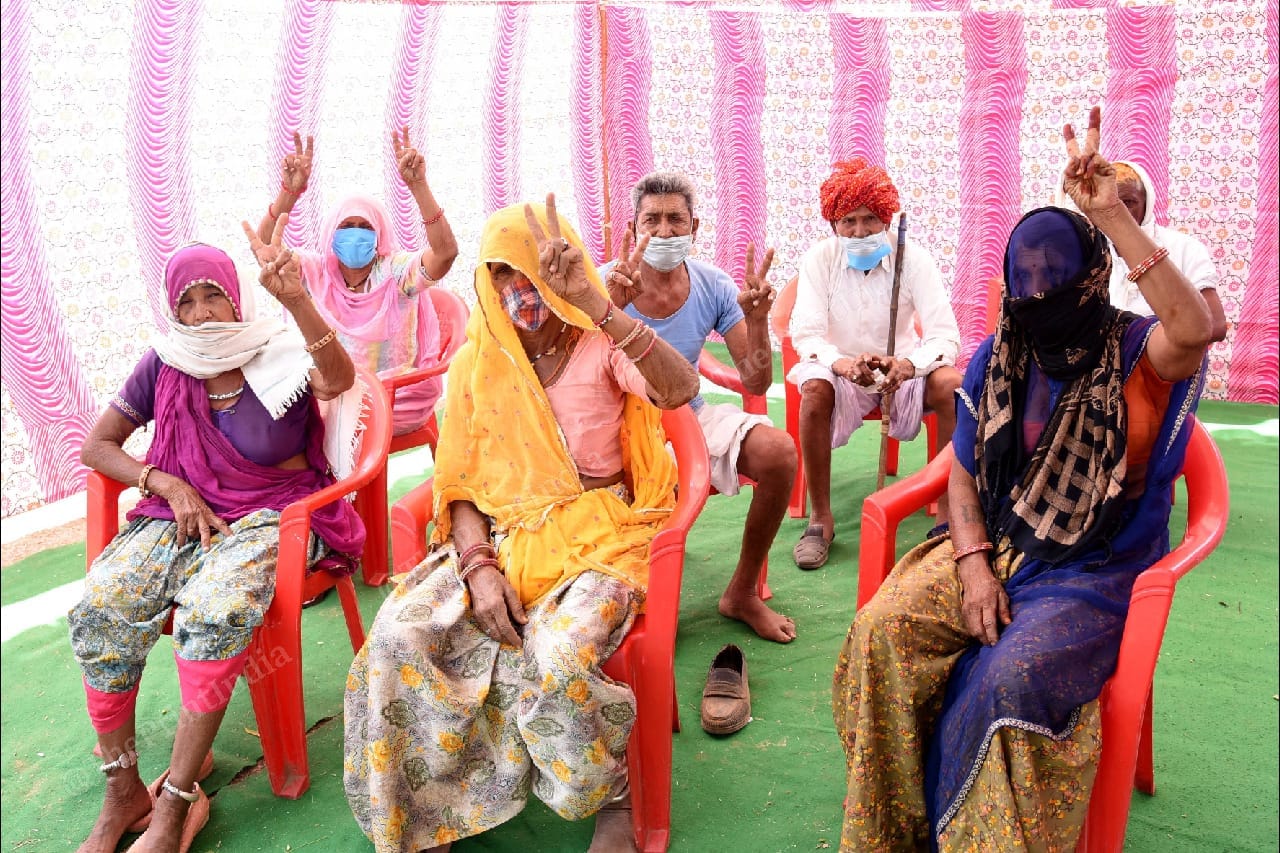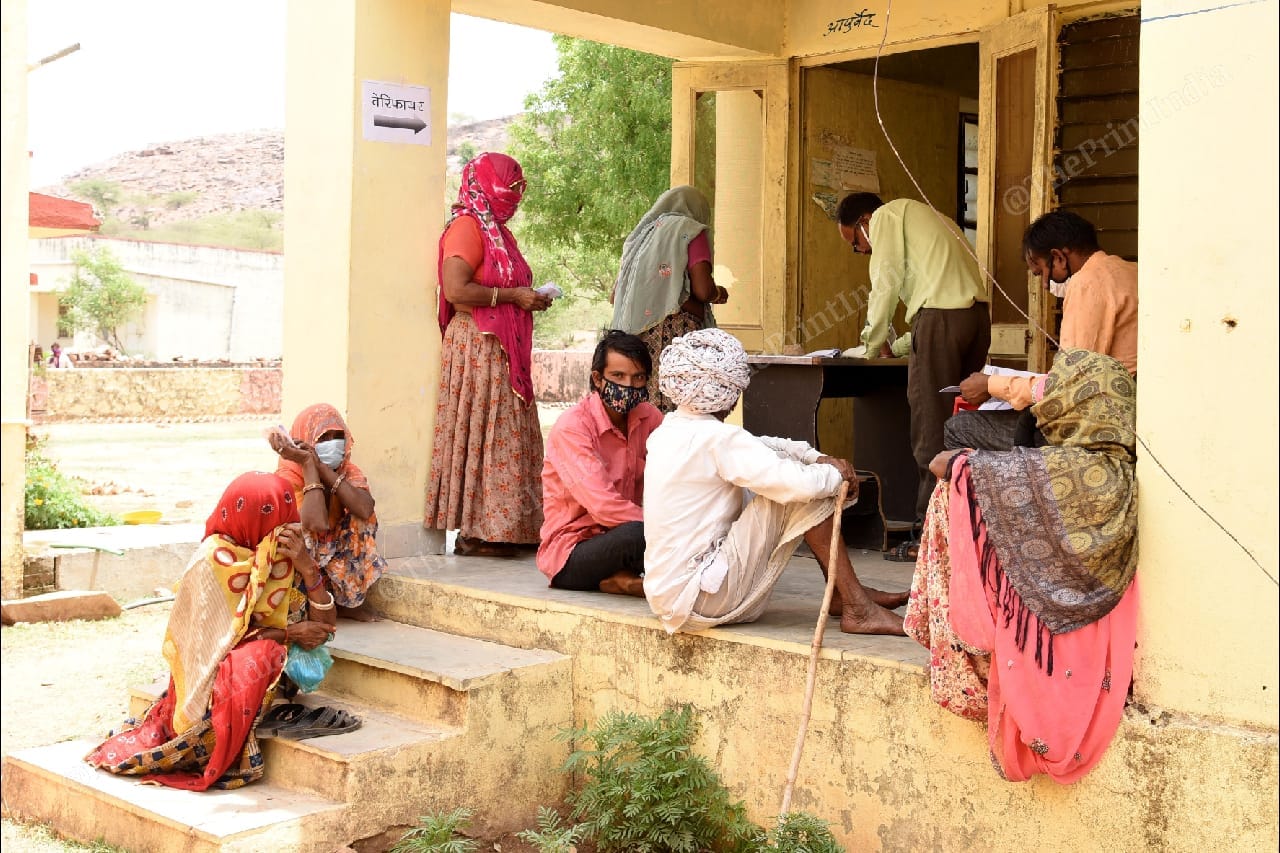Jaipur: On Sunday, Chauser Meena Devi, 55, got her second dose of Covishield in Bhilwara district’s Jalindri village. She was worried about “pain” initially but decided to take the shot anyway after her sister and brother-in-law got it.
Sitting in the scorching summer heat under a tent at a vaccination centre, she was surrounded by at least 12 more women — all covering their faces with ghoongat as an alternative for a mask. Speaking to ThePrint, these women said they overcame their vaccine hesitancy after seeing people in their families and neighbourhood take the shot.
But behind this seemingly simple change of mind lies the work of people at multiple levels of the Rajasthan government.
Auxiliary nursing midwife (ANM) staff Mamata Ujjaini and Monica Chaudhary work at a Covid-19 vaccination centre in Bhankrota, a small town near Jaipur. They have been involved in the government’s Covid fight since August last year — from contract tracing to spreading the word about vaccine benefits.

Their sincerity was visible when they asked this reporter to not interrupt a counselling session with a group of four 70+ men to eliminate their vaccination fears. “Every single person counts, if four will get convinced they will convince four more in their families,” Ujjaini said.
While guiding a beneficiary to the vaccination room at the centre, Madhubala, an Accredited Social Health Activists (ASHA) worker said, “Some people don’t agree easily but we can’t give up. We try reaching out to another person in the family. We have to continue with our efforts.”
This tireless leg work done by ANMs is aided by ASHA and Angadwadi workers, and village sarpanches. And combined with prompt planning, proactive coordination and social media campaigns, has brought Rajasthan to among the top Covid vaccination performers in the country.
Also read: ‘Example for other states’: Centre assures action after Rajasthan seizes oxygen tankers
Rajasthan’s vaccination performance
As of 25 April, Rajasthan has inoculated 1.23 crore people against the novel coronavirus — out of a population of 8.7 crore (nearly 14 per cent), showed state government data accessed by ThePrint. Of this, 1.03 crore have received the first dose while around 20 lakh have got the second dose as well, data showed.
Rajasthan has conducted the highest number of vaccinations among the states. It touched the 1-crore mark on 12 April.
Among the large states, only Gujarat has vaccinated a higher proportion of its population (with at least one dose), at 14.53 per cent, according to data publicly shared by health economist Rijo M. John as of 24 April. However, its population is less than Rajasthan’s.
Maharashtra, another top performer, has managed to vaccinate 9.9 per cent with the first dose. It has also conducted over 1 crore vaccinations, data showed.
24 April #COVID19 snapshot:
?348979 new cases, 2761 deaths & 17.2L tests y'day.
?7-day average TPR: 19%
?26.7L active cases & growing at 5.9%
?Total: 16.95M cases, 192310 deaths
?14.09 crore vaccination doses given (2.5M y'day) pic.twitter.com/2XTEUTYcHy
— Rijo M John, PhD (@RijoMJohn) April 25, 2021
However, these numbers weren’t achieved overnight.
In January, Chief Minister Ashok Gehlot had raised concern over the low inoculation numbers, following which multiple video conferences were held by the state Health Secretary, Sidharth Mahajan, with district collectors to spread awareness.
Speaking to ThePrint, Mahajan said the results were visible in a month.
According to state health department data Mahajan shared, 7.44 lakh people — 3.92 health workers and 3.52 frontline workers — received their first shot on 17 February, two days after the second dose began being administered. Over 15,000 people received the second shot the same day. Things improved quickly soon after, he said.
On Sunday, Rajasthan also announced free vaccination for people between 18-45 years of age from 1 May.
Also read: Rare good news on Covid: Chhattisgarh R drops below 1, other states see infection rate dip
Village level panels and Swasthya Mitras lead vaccination drive
To drive the vaccination figures up, committees have been constituted in each village under the aegis of sarpanches to encourage the local population to take the shot.
ASHA workers, ANMs and data operators are also part of these village panels. They started their work even before the vaccine drive formally began on 16 January. “We began mobilising the crowd in December itself,” said Prem Devi Sharma, sarpanch, Jalindri.
He said the number of beneficiaries were 200 a day even at a centre which is far from the city. “Only recently, we have been getting only 70 people since we were short on vaccine and had to close the centre on some days,” he said.

Madhubala, the ASHA worker on duty in the village, shared how initial apprehensions about fever were tackled. “Once they get the shot and realise the fever might only last a day and some might not even get it, they encourage others in the village,” she said.
Over 60,000 Swasthya Mitras, male and female village volunteers part of the government’s flagship health scheme Nirogi Rajasthan, also carried out door-to-door surveys in January and February to convince people to take the shot.
Kalu Banjara, a 65-year-old in Jalindri, said it was a Swasthya Mitra who reminded him about the date for his second dose.

Healthcare staff take lead, officers & teachers aid fight
To push the drive, senior officials in the Congress-led government also made personal appeals over video conferences to healthcare and frontline workers to take the shot.
“There was a point in January-end where our daily vaccine numbers were quite low and we had to really buck up our staff,” Health Secretary Mahajan said. This is when revenue department officials were brought in and allotted dedicated groups of people as target for vaccination, he added.
Utsah Chaudhary, Sub-Divisional Magistrate, Mandalgarh, who spearheaded vaccination in tribal areas in the state, said: “Teachers also played an important role in spreading the message. The locals here take their word very seriously.”
Deepak Sharma, the doctor at the vaccination centre, said the primary health centre staff also posted visuals on Facebook to encourage other healthcare workers.
Videos of prominent people, including doctors, civil servants and public representatives were also shown to healthcare and frontline workers to help erase apprehensions about vaccine.
“The videos were shared over VCs, on social media platforms and even WhatsApp groups,” Raghuraj Singh, State Immunisation Officer told ThePrint.
According to state government data, 86.4 per cent of healthcare workers and frontline workers registered (9,64,894) on Co-WIN have received the first dose while 81.2 per cent of frontline workers registered (9,12,828) have received the second dose.
“These HCW and frontline staff then got their jabs and started sharing their own images with neighbours and even created smaller WhatsApp groups wherein they would share their own images with the public to spread awareness among them,” he added.
Now, in the smaller villages of the state, autos with loud speakers spreading awareness on the vaccination drive can be seen.
CM’s proactive efforts
But it wasn’t just the middle and lower rungs of the administration that were burning the midnight oil. CM Gehlot was leading from the front, say members of the state’s Covid Task Force. According to them, proactive governance by the CM and his cabinet also helped keep the motivation levels up during the pandemic.
“We haven’t slept more than two hours in days amid this second wave but the CM would be as alert during the 3pm meetings as he would at 11:30pm at night,” said a senior task force member who didn’t wish to be identified.
Even on the days leading to the bypolls in the state this month, Gehlot didn’t skip any Covid review meeting, even if it meant calling for one at 10pm after completing election related work.
Moreover, he also involved opposition leaders during major decisions amid the pandemic and kept political differences aside, said a senior civil servant in the Covid team who didn’t want to be named.
“After Rajasthan increased the testing capacity last year, the CM would tell us that now we must top the vaccination figures too in the country,” a cabinet minister told ThePrint on condition of anonymity.
Also read: India’s vaccine shortage threatens to prolong its Covid crisis






